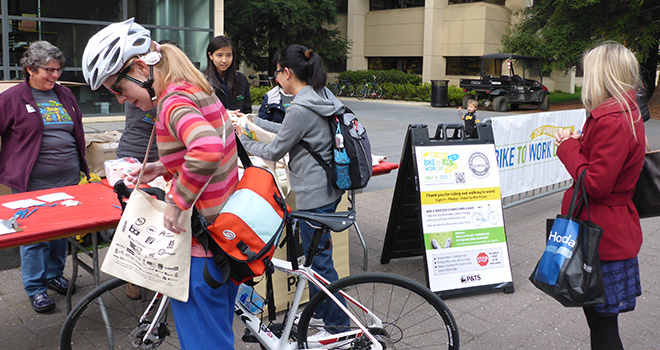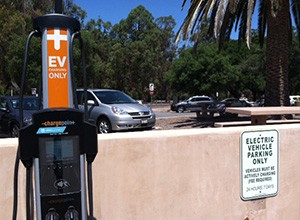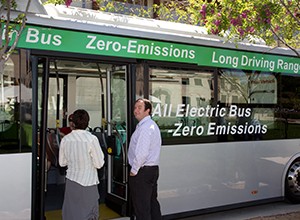Despite significant campus growth, the TDM program has resulted in measurable reductions in commuter emissions, and it plays an essential role in the university’s sustainability effort.
The Stanford Commute Club is a key element of the TDM program. The Commute Club rewards each member with up to $300 a year, among other incentives, for commuting primarily by alternative transportation. In 2014-15, Commute Club membership increased 8% over 2013-14 levels. Stanford has also continued to expand other transportation programs, including car sharing, and now boasts one of the largest university Zipcar programs in the nation.
As one of the nation’s first Platinum-Level Bicycle Friendly Universities, Stanford has expanded its bicycle program to accommodate an estimated 13,000 bikes on campus each day. The expansion has included adding bicycle safety repair stands, which now total seven, and increasing bicycle parking capacity. In 2014-15, Stanford added three bike locker compounds on campus, providing a total of 44 bike lockers. This brings the total for secure bike parking spaces to 440 (331 in bike lockers and 109 in bike cages). In addition, Stanford provides more than 19,000 bike rack parking spaces on campus.
These TDM advances, coupled with extensive marketing outreach and promotions, have enabled Stanford to reduce its drive-alone rate by 32% since 2002, with half of university employee commuters now primarily using sustainable transportation.
Results
Stanford has been transitioning to more sustainable campus shuttles and fleet vehicles, adding electric vehicle (EV) charging stations, increasing shuttle route efficiency, and expanding its other sustainable transportation efforts.
In 2014, the employee drive-alone rate totaled 49%, compared to 72% in 2002 at the inception of the enhanced TDM program.

Bikers checking in at Bike to Work Day
Additional achievements for 2014-15 include the following:
- Marguerite—Stanford’s free public shuttle service that travels around campus and connects to nearby transit, shopping, dining, and entertainment—passenger numbers rose from 2.3 million in 2013 to an estimated 2.5 million in 2014.
- In 2014-15, Stanford increased its efforts to encourage and reward sustainable commuting. Stanford introduced a new ride-sharing service, Ride, engaging the campus community with launch events, incentives to register, and new subsidies for the first five new vanpools formed. The Commute Club also offered a new membership gift: a 2015 desk calendar featuring winning photos from the “Why I Commute the Way I Do” photo contest. The photo contest invited Commute Club members to submit photos showing why they choose a sustainable commute.
- Bike to Work Day at Stanford saw a record turnout in 2015. Volunteers counted more than 2,000 riders, and 807 riders reported logging a total of 6,386 miles, for an average of eight miles per trip. By biking instead of driving, these commuters (plus 279 pedestrians) eliminated an estimated 5,786 pounds of CO2 emissions on Bike to Work Day.

An electric vehicle station on campus
- Stanford more than doubled the number of EV charging stations on campus, replacing six charging stations with 14 new stations in high-demand parking areas. Stanford now has a total of 16 EV charging stations, including off-campus sites. All stations are Level 2 (240V charging via SAE J1772 connector).
- Three 81-passenger double-deck buses were added to the Marguerite fleet to augment the 49- and 57-passenger motor coach buses that serve the East Bay on the expanded East Bay Ardenwood Express route.
- Throughout 2014-15, Stanford promoted the Caltrain Go Pass as part of a pilot program beginning on September 1, 2014, which enables graduate students and postdoctoral scholars to purchase the pass at a significant discount. The Go Pass provides unlimited rides in all zones throughout the calendar year.
Stanford hosted a Corporate Bike Forum, which drew more than 30 leading Silicon Valley businesses to share best practices and what challenges they face with their bicycle programs. Over 40% of Stanford’s 1,100 fleet vehicles are electric, and the number of hybrid vehicles increased to 36 this past year. In addition, a bike fleet comprises 5 electric bikes and 16 pedal-powered bikes. The Marguerite shuttle fleet includes 13 electric buses, 5 diesel-electric hybrid buses, and 61 vans, shuttles, and buses fueled by biodiesel. Parking & Transportation Services (P&TS) added a plug-in hybrid vehicle to its department fleet.
Academic Integration
Stanford’s P&TS office engaged in several academic partnerships in 2014-15:
- P&TS worked with the School of Education’s Social Ecology Lab to examine the relationship between learning and travel behavior: which conditions and mechanisms impact that link and the role(s) that institutions do or do not play in commute choices and behavior. Research methods included a survey of employees, interviews and commute documentation with up to 10 employees, observation of transportation-related events (e.g., Bike to Work Day, employee orientation events, Commute Club events), focus groups, and document analysis. Existing survey and other data from P&TS will be used as background and baseline data.
- Working with the Precourt Energy Efficiency Center, P&TS collaborated on a study to evaluate what TDM measures are relevant and applicable to employees’ mode choices. Research included a series of focus groups to understand employee transportation and parking behavior and the underlying factors that determine employees’ attitudes toward existing and hypothetical transportation and parking policies.
- P&TS worked with Stanford graduate students and postdoctoral scholars from the Graduate School of Education, Statistics Department, and Precourt Energy Efficiency Center to improve the research methodology used in developing its annual commute survey.
- P&TS consulted with a group of Summer Undergraduate Research Institute (SURI) students on an an opensource transportation modeling system that highlights the benefits of purchasing electric buses compared with conventional diesel, compressed natural gas, or hybrid buses. Once completed, this model could help other universities or municipalities determine institutional benefits realized through the electrification of their fleet, such as total savings compared to initial cost.
Looking Ahead
Many new and exciting TDM initiatives are in development, including plans to address Stanford’s long-term growth both on and off campus.
The existing EV charging policy is undergoing a review that includes assessing the number and location of stations to be installed in the future and determining charging-level options. With the construction of a new, underground parking structure, the university plans to add 50 more EV charging stations in 2016.

An electric bus on display
Based on the performance of its 40-foot electric buses (13 have been added to the Marguerite fleet since 2013), Stanford plans to add 10 more 30-foot electric buses, which will replace older buses in the fleet.
TDM remains a priority sustainability program at Stanford, with implications beyond the university’s main campus. With current commute trends in Silicon Valley pointing to an increase in traffic congestion, Stanford is also launching a regional transportation planning initiative under the leadership of Land, Buildings & Real Estate.



